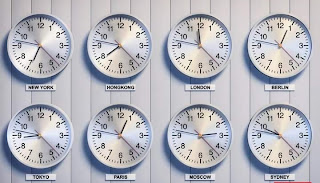Travelers to new areas often struggle to match the clock or laptop time to the local time. Again, many people miss meetings with foreign clients due to not paying attention to the time zone.
The concept of time zones begins so that the position of the sun corresponds to the time on our clocks. But this matter bothers us a lot while communicating with someone far away or moving from one region to another.
Surprisingly, time zones were created to reduce confusion, not increase confusion. When you move across Earth, even a short distance, solar time changes. So in human history we have seen more and more different time of day from place to place.
“Time was determined by just looking at the position of the sun, the sundial used to tell what time it was,” explained Steve Hahnke, professor of applied economics at Johns Hopkins University in Baltimore. London is 10 minutes earlier than Bristol, because London is 120 miles (193 km) east of Bristol. Even after Europe began using mechanical clocks around 1300, this average of time remained accurate across locations.
How Time Zones Began From Railways
Until the 1800s, people didn’t really bother with accurate time. But when rail became popular for getting from one place to another in less time, the need for accurate time was realized. It was found that people started missing trains, and even two trains collided head-on due to timing errors.
Europe wasn’t the only one struggling with time zones. The United States was also in trouble. Because every city in the US had a different time. There are a total of 300 local time zones in the United States, but this is reduced to 100 for railroads.
One day in 1876, Scottish-born engineer Sir Sandford Fleming missed a train due to a scheduling error. Since then he thought of fixing a universal standard of time measurement. From Fleming’s innovative idea, the whole world is divided into 24 time zones. The difference between each time zone is about 15 degrees when calculated along the line of longitude.
In this global system, without counting the solar days of each location, the Royal Greenwich Observatory in the United Kingdom is taken as the standard. It is assumed that the sun is located here on the prime meridian. Greenwich is considered as the Prime Meridian (or Prime Meridian) because it is the dividing line between the Western and Eastern Hemispheres of the Earth.
On November 18, 1883, the day known as the “Day of Two Noons”, North American railroads began to observe only 4 time zones. These are Eastern Time, Central Time, Mountain Time and Pacific Time.
Many cities have even passed ordinances to adopt this system. At one time it became recognized throughout the United States. Adopting GMT causes another phenomenon. It also ended the competition that was likely to be the main median between US cities.
Can We Reduce The Time Zone?
Confusion about time began again in the 20th century, with only 24 time zones. In this century, air travel further reduced distances. And because of mobile and internet, instant communication with people from all corners of the world becomes easy. The result is a twenty-four-seven culture where we can connect to events at any distance at any moment.
So a few years ago Hahnke and his colleague Richard Kahn Henry, professor of physics and astronomy at Johns Hopkins University, proposed a simpler solution.
They want to do away with time zones altogether and bring the whole world into just one time. This time is called Universal Time (UTC). In this system, when it is 9 o’clock anywhere in the world, it means that it is 9 o’clock everywhere in the world. It might be noon somewhere, or evening somewhere, but that’s no problem.
Having only one time will be very convenient during travel. If you want to call a Zoom meeting with your colleagues in Germany sitting in Bangladesh, it will also become very hassle free. Being the chairman of the board of a Dutch company, Hahn himself calls such multinational online meetings, so he is well aware of this issue. “This endless confusion about time will then end forever. And our lives will be so much easier,” Richard Henry agreed with Hanke in an e-mail.
Bestselling author and New York Times columnist James Gleick has also supported the idea since Hanke and Henry proposed abolishing time zones in 2012. Global time has already begun, albeit on a small scale.
How UTC Or Universal Time Is Used
US pilots and air traffic control engineers, however, work on Universal Time, or UTC. Those who do financial transactions in different time zones, but also work according to global time. Otherwise the price of the product may vary. And the internet always follows global time.
Now one might think that the start of global time will disrupt the normal routine of people. But Han doesn’t think so.
“People say if we all stick to the same hours, then I have to open the shop late at night. Of course not. Your store will still open at the same time you do now. In New York or Baltimore, people usually open their shops at 9 o’clock. So just assume it is 14:00 or 2:00 PM on your watch. (If taken as 9am GMT).
It will take some time for people to get used to this system in the beginning. However, Hanke believes that the next generation of children who will grow up watching UTC will no longer think of 7am as breakfast time and 9am as work time.
“China is in a big problem right now because it has only one time zone for its vast east-west real estate.” “Their problem is completely solved when they decide locally when businesses will open and close,” Henry added. To implement a global system, we must do something like that.”


